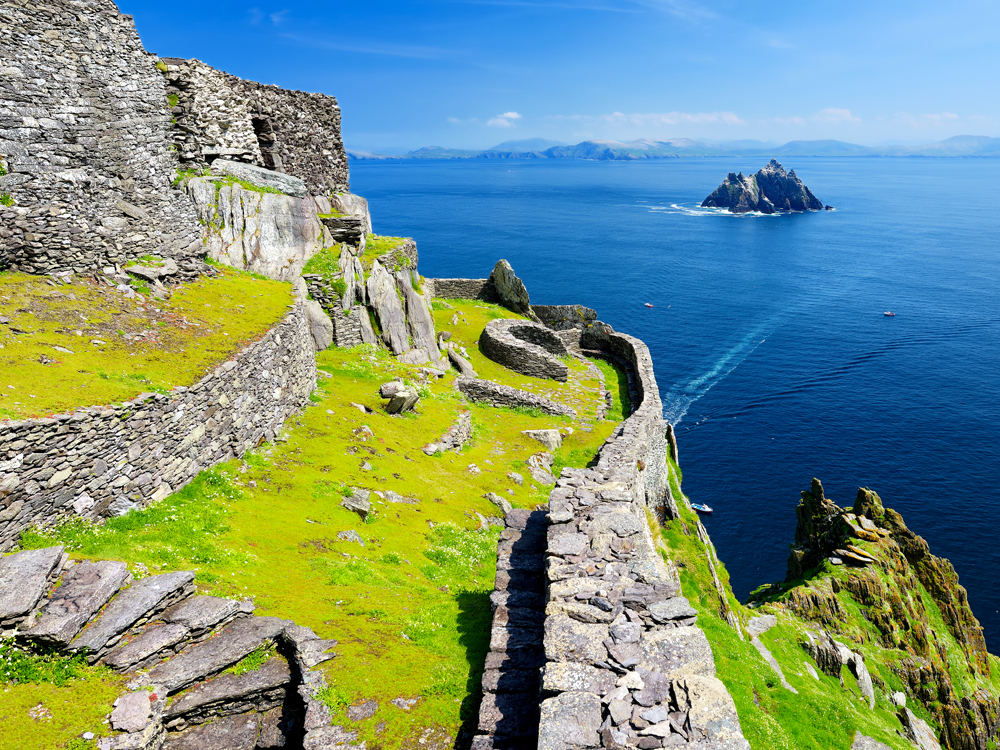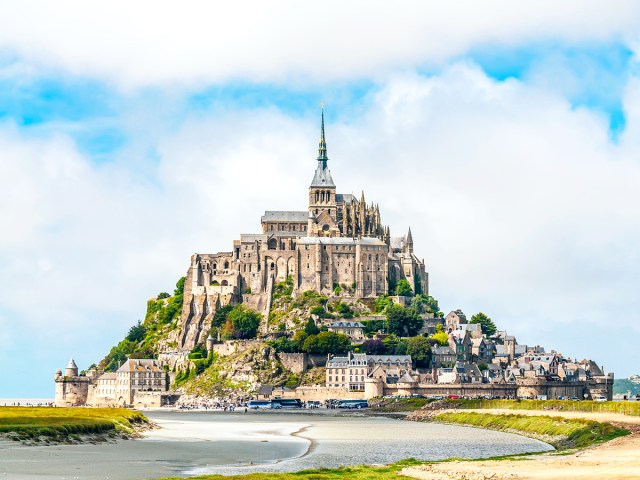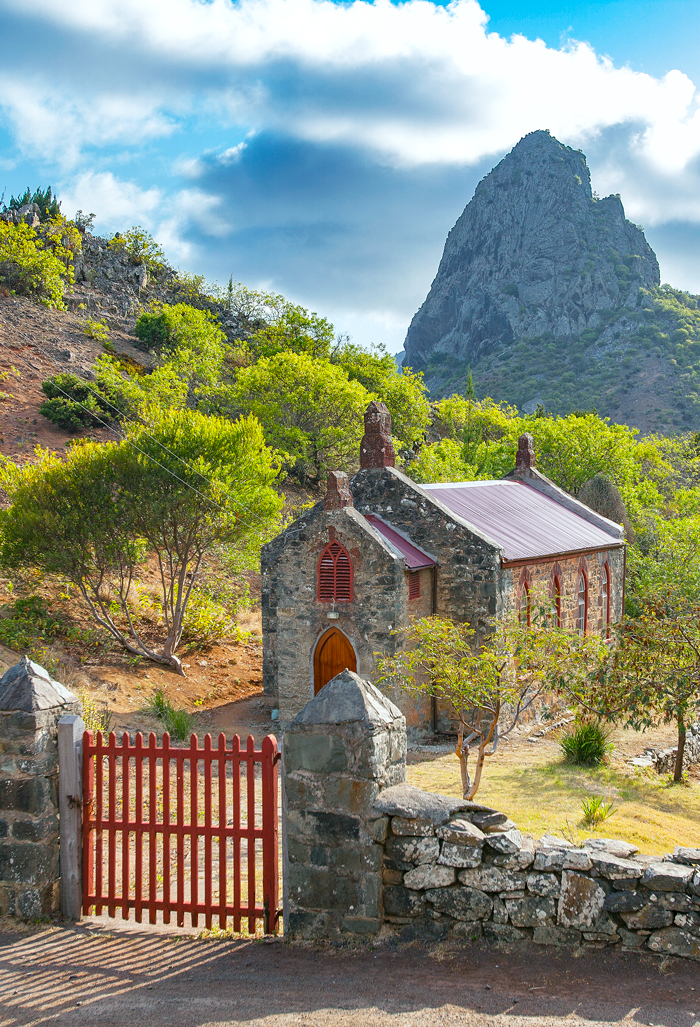The planet is dotted with islands, some home to millions of people and others small, rocky outcrops located thousands of miles from the nearest continent. Given their geographic isolation, often the people who inhabit Earth’s many islands develop unique cultural identities or use them for fascinating purposes. That’s certainly the case with the islands beow. From an Irish island home to a community of monks for centuries to the island where infamous ruler Napoleon Bonaparte met his fate, these are seven of the world’s most interesting islands.
Skellig Michael – Ireland

Skellig Michael (Sceilg Mhichíl in Irish) — a rocky, green outcropping 12 miles off Ireland’s southwest coast — doesn’t look all that inviting from shore. That was exactly its attraction for the community of monks who took up residence there in the sixth and seventh centuries CE. Early Christians sought austerity and solitude, and the island offered those in abundance. For 600 years, monks lived on Skellig Michael in stone beehive huts (so named for their rounded and tapered shape), perched on human-made terraces on the rocky island slopes along with a hermitage, church, garden, and cemetery. The monks subsisted on what vegetables could be grown on this wind-whipped island, the fish that could be caught in the wild sea below, and the eggs of the large colony of gannets and puffins.
Around the 13th century, the monks decamped for the mainland, but the island remained a place of pilgrimage. It was added to UNESCO’s World Heritage list in 1996, with the notation that — except for some destruction wrought by Vikings and 19th-century lighthouse construction crews — Skellig Michael has been protected by its isolation. In 2015 and 2017, film crews swarmed the monks’ island during production of two Star Wars movies, The Force Awakens and The Last Jedi, introducing its solitary beauty to film audiences worldwide.
Governors Island – New York

Despite its location just a few hundred yards off the southern tip of Manhattan, serene Governors Island couldn’t have more of a different feel from Manhattan’s concrete bustle. The 172-acre island — located in New York Harbor at the confluence of the Hudson and East rivers — was originally inhabited by Lenape Native Americans, who named it Paggank (“Nut Island”) after its plentiful nut trees. The British colonial assembly in New York later designated it for private use of its royal governors, which is how the island got its current name. It then served as an important military fortification, part of a larger coastal defense network, and after that, it served as the largest U.S. Coast Guard base for 30 years.
In 2003, the island was designated as the Governors Island National Monument, and in 2012, the island was opened to the public as a seasonal park, accessible by a quick ferry ride. The park hosts a number of seasonal concerts and events, including the Jazz Age Lawn Party, and even has overnight glamping accommodations. The southern end of the island features the longest slide in the city, and visitors can enjoy leisurely bike rides, a nap in a hammock, and a waterfront promenade — alongside panoramic views of Lower Manhattan, Brooklyn, and the Statue of Liberty.
Eel Pie Island – London, England

The only inhabited island in the Thames River, Eel Pie Island was supposedly named after a traditional Victorian-era working class dish, which made use of the plentiful eels off the island’s shores. But rather than eel pies, the island has long had a reputation as a hotbed for hippies to party. Though a pedestrian bridge now connects it to the mainland, the island was long accessible only by boat — providing privacy to those in search of recreation and a fresh air escape from London.
Originally a 19th-century retreat, the Eel Pie Island Hotel was rebuilt and reopened, with the addition of a dance hall in the 20th century. The tasteful tea dances of the 1930s and 1940s gave way to less respectable jazz shows in the 1950s, all leading up to a period that cemented the island’s reputation as a birthplace of British R&B music. In 1963, the Rolling Stones played a regular Wednesday night gig at the hotel, and, before the building mysteriously burned down in 1971, its stage also hosted the likes of Genesis, Pink Floyd, John Mayall’s Bluesbreakers (with young Eric Clapton on the guitar), the Yardbirds, and Black Sabbath. Today, the secluded nine-acre island is inhabited by a community of artists who invite the public twice a year for open studio events. Another small group of residents live a clutch of houseboats moored to the island’s Thames-facing side.
Jeju Island – South Korea

On the basis of its landscapes alone, the southernmost, largest, and youngest island in South Korea — and home to the nation’s highest mountain, Hallasan — would be worth visiting. A wonderland of lava tube caves, geometric stone pillars, and other stunning remnants of long-ago eruptions, Jeju has been designated a UNESCO Global Geopark, Biosphere Reserve, and World Heritage Site. (The site was also a plot point on Squid Game, the South Korean TV show that became a global phenomenon via Netflix.)
But for all of Jeju’s UNESCO-anointed nature, an entry on the organization’s Intangible Cultural Heritage list piques at least as much interest in the island: the Haenyeo, or “sea women.” Carrying on a centuries-old local tradition, these remarkable female divers harvest seafood from the ocean floor on nothing but their own lung power. The typical dive may take them to depths of more than 30 feet (and back) in just a couple of minutes. That’s all the more impressive when you consider that the women are mostly 60-plus years old — in recent decades, their numbers have dwindled as women have left the island and opted for more modern work. However, their ranks still include trainees, who learn from the most experienced divers (called sanggun) and schools exist to reinforce that training and preserve associated traditions. To learn more, you can visit the island’s Haenyeo Museum or catch the demos at Seongsan Ilchulbong.
St. Helena Island – British Overseas Territory

Elba, off the coast of Italy, wasn’t the only island Napoleon Bonaparte was exiled to — the emperor met his demise on an island so remote that the nearest major landmass is 1,200 miles away. Covering only 47 square miles in the South Atlantic, St. Helena Island is one of three islands that make up the British overseas territory of St. Helena, Ascension, and Tristan da Cunha. Despite its remote location and tiny size, St. Helena Island has a rich history: In addition to Bonaparte — whose Longwood House is now a museum — the island has welcomed naturalist Charles Darwin, explorer James Cook, astronomer Edmond Halley, and Dinuzulu (the last king of the Zulus).
Even more alluring than the history are the island’s natural wonders. With almost no light pollution, stargazing is magnificent. Underwater, divers revel in reefs and shipwrecks humming with fish, rays, and turtles. Animal lovers should look out for quirky endemic birds, spiders, and snails — plus the opportunity to swim with whale sharks or spot humpback whales and their calves. The volcanic island offers plenty of rugged terrain for hikers, too. And thanks to an airport that opened in 2017 and replaced a six-day boat journey from South Africa, St. Helena is, finally, more accessible than ever before.
Assateague Island – Maryland and Virginia

This rugged 37-mile-long barrier island — two-thirds in Maryland, the rest in Virginia — beckons visitors with unspoiled sandy beaches, salt marshes, hiking trails, and numerous campsites. But unlike other islands in the Chesapeake Bay, this one is home to a herd of majestic wild horses, who have roamed there for hundreds of years.
No one is sure how exactly the horses got to Assateague Island. A popular local legend says they swam to the island after surviving the shipwreck of a long-lost Spanish galleon. But other experts have a somewhat less exciting theory: that colonists brought horses to Assateague from the mainland to avoid taxation and simply left them there. Whatever the reason, the feral horses now roam freely on both sides of the island, except for once a summer, when thousands of spectators gather on boats in the bay or on the beach to watch the annual pony swim. “Saltwater cowboys” swim the herd’s ponies across the narrow channel to nearby Chincoteague Island, kicking off a week-long event that celebrates Assateague’s unique history.
Mont-Saint-Michel – France

One of Europe’s most enchanting medieval vistas is this Benedictine abbey that dominates a small tidal island just off the coast of Normandy. If it appears straight out of a Disney film, that’s because it is: The magical island inspired Disney animators when they drew up Rapunzel’s birthplace in the 2010 film Tangled. The island’s namesake abbey flaunts slender spires that jut up from the surrounding rocky cliffs, with architecture that dates back to the eighth century. Remarkably left intact following the Hundred Years’ War and both World Wars, Mont-Saint-Michel is now a UNESCO World Heritage Site that welcomes more than 3 million visitors annually.
The changing tides of Mont-Saint-Michel present a fascinating contrast: As tides recede, a bed of shimmering, sifting sand appears as a cushion around the island, but when waters are high, it seems to float in the bay. The abbey was cut off from the mainland until the late 19th century, but visitors can now cross a bridge to discover a walled village of narrow cobblestone alleys and stairways, home to restaurants, hotels, and a full-time population of just 30 people.
More from our network
Daily Passport is part of Inbox Studio, which publishes content that uplifts, informs, and inspires.
















